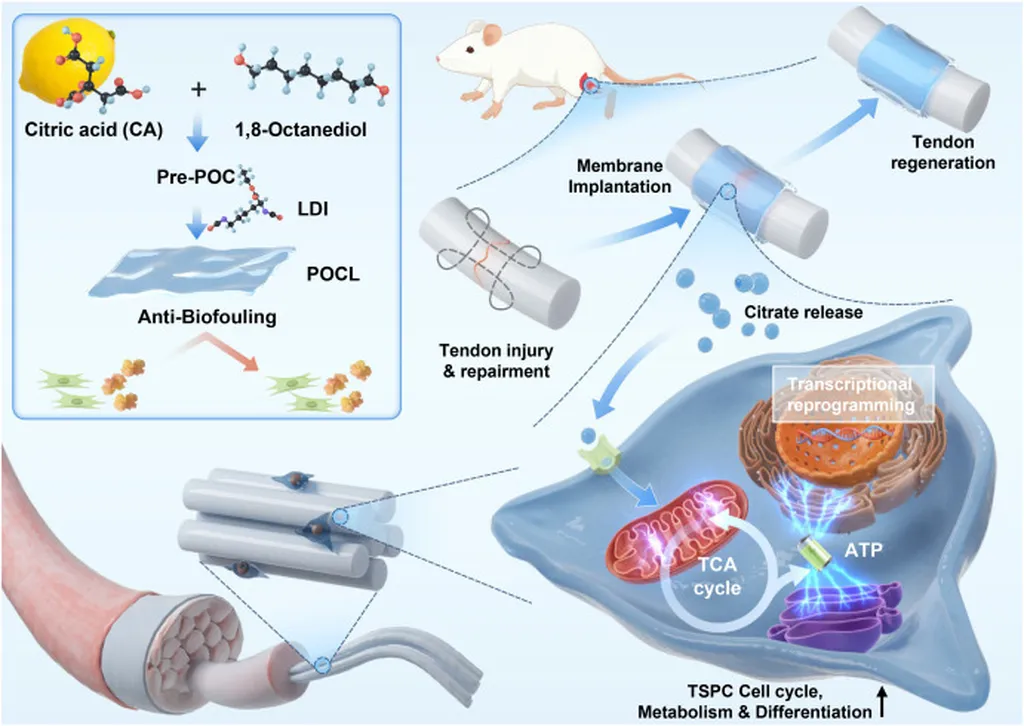In the realm of regenerative medicine, a groundbreaking development has emerged from the labs of Shanghai Sixth People’s Hospital, affiliated with Shanghai Jiao Tong University School of Medicine. Researchers, led by Changhao Han, have introduced a novel biodegradable polymer membrane that could revolutionize tendon repair and anti-biofouling strategies. This innovation, detailed in a recent study published in *Bioactive Materials* (translated as *活性材料*), holds significant promise for the energy sector, particularly in applications requiring sustainable energy metabolism regulation.
The study focuses on tendon stem/progenitor cells (TSPCs), which are pivotal for the intrinsic regeneration of injured tendons. These cells rely heavily on the tricarboxylic acid (TCA) cycle, a crucial metabolic pathway. Citric acid, a key substrate in this cycle, has been identified as a promising candidate for regulating energy metabolism. However, until now, sustainable methods to provide these energy metabolic substrates throughout the entire regeneration process have been overlooked.
Enter the metabotissugenic membrane, a biodegradable polymer composed of poly(octamethylene citrate) and L-lysine diisocyanate, dubbed POCL10. This innovative membrane consistently biodegrades, providing a steady supply of citrate substrates. “The POCL10 membrane not only biodegrades to release citrate but also exhibits self-sealing properties due to strong hydrogen bonds,” explains Han. This dual functionality enhances its potential for medical applications.
The POCL10 membrane has demonstrated remarkable capabilities in vitro, showcasing anti-biofouling properties and significantly upregulating TSPC proliferation, energy metabolism, and differentiation. In vivo tests revealed that the membrane could be effortlessly wrapped around injured Achilles tendons, preventing tissue adhesion and promoting collagen organization. The result was strengthened biomechanical properties, indicating a robust regenerative capability.
The implications for the energy sector are profound. The sustainable provision of energy metabolic substrates could enhance the efficiency and longevity of various energy-dependent processes. “This research expands the reservoir of available biodegradable citrate-based biomaterials,” Han notes, highlighting the potential for broader applications in regenerative medicine and beyond.
The development of POCL10 represents a significant leap forward in the field of biomaterials. Its unique properties and regenerative capabilities could pave the way for innovative solutions in tendon repair and anti-biofouling strategies. As the energy sector continues to seek sustainable and efficient methods, the insights from this research could inspire new approaches to energy metabolism regulation.
In summary, the work of Changhao Han and his team at Shanghai Sixth People’s Hospital offers a compelling glimpse into the future of regenerative medicine. The POCL10 membrane’s ability to consistently provide citrate substrates, coupled with its self-sealing and anti-biofouling properties, positions it as a promising candidate for various medical and industrial applications. As the research continues to evolve, the potential for transformative impacts on the energy sector becomes increasingly evident.

